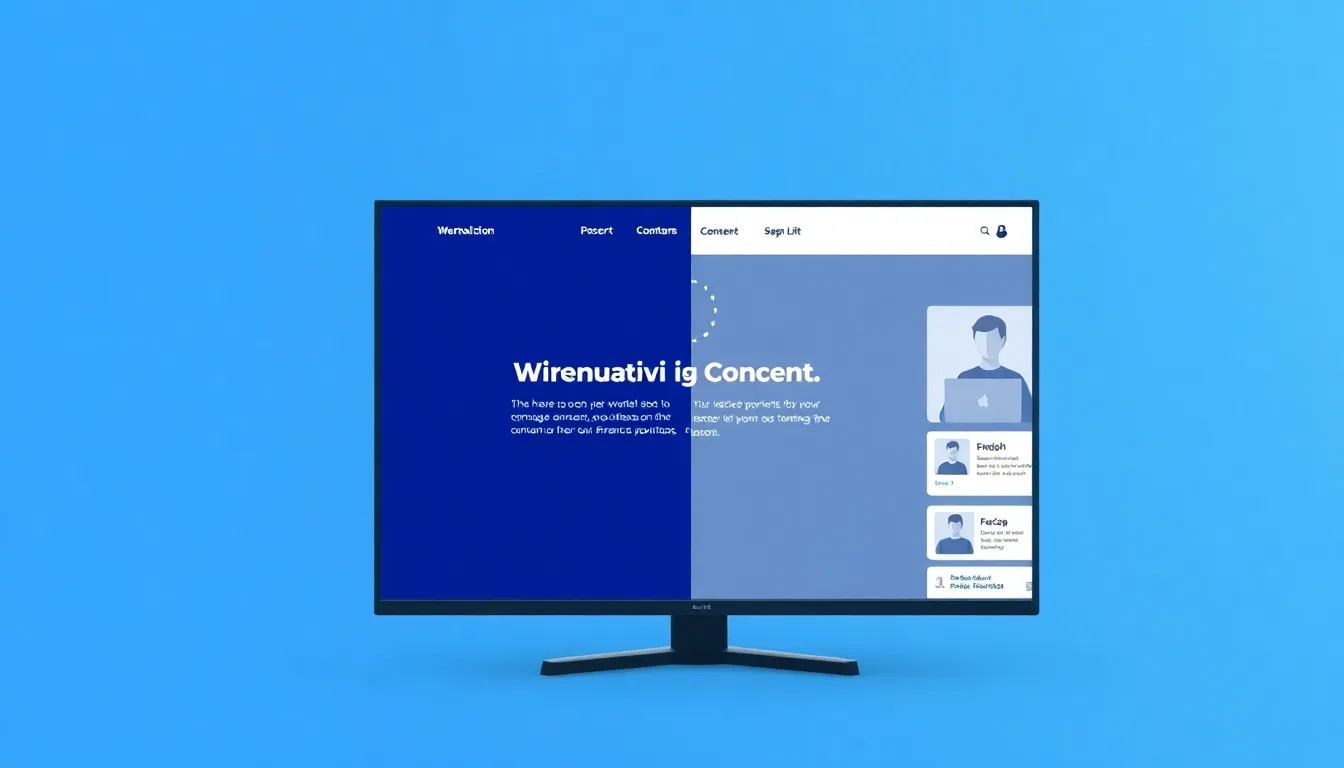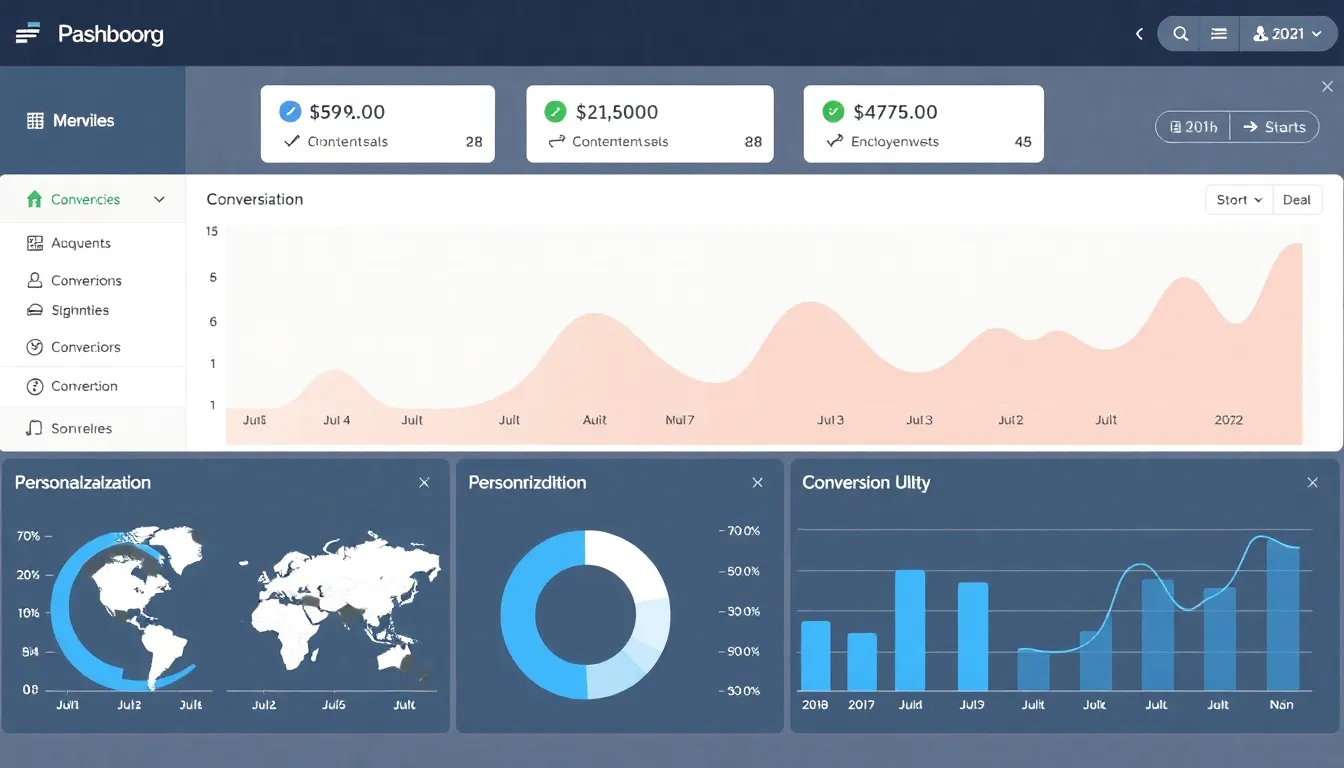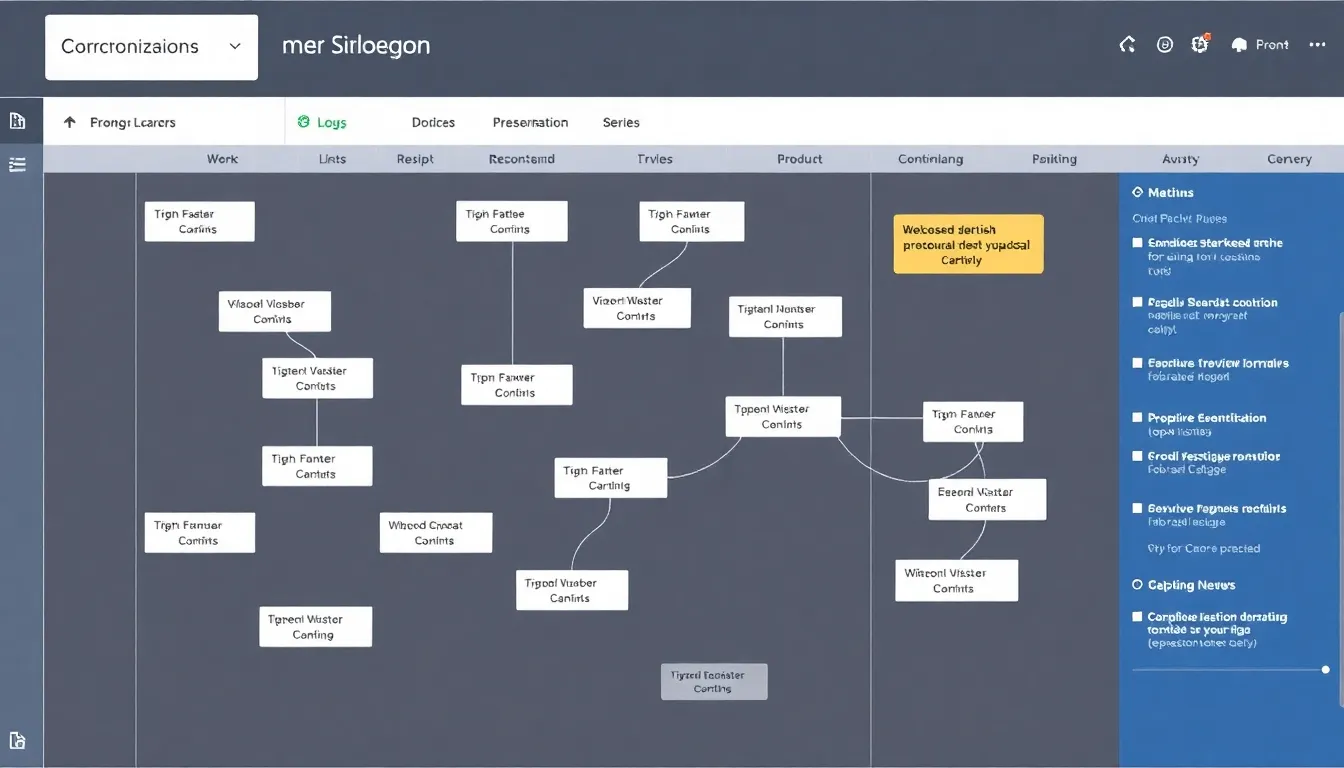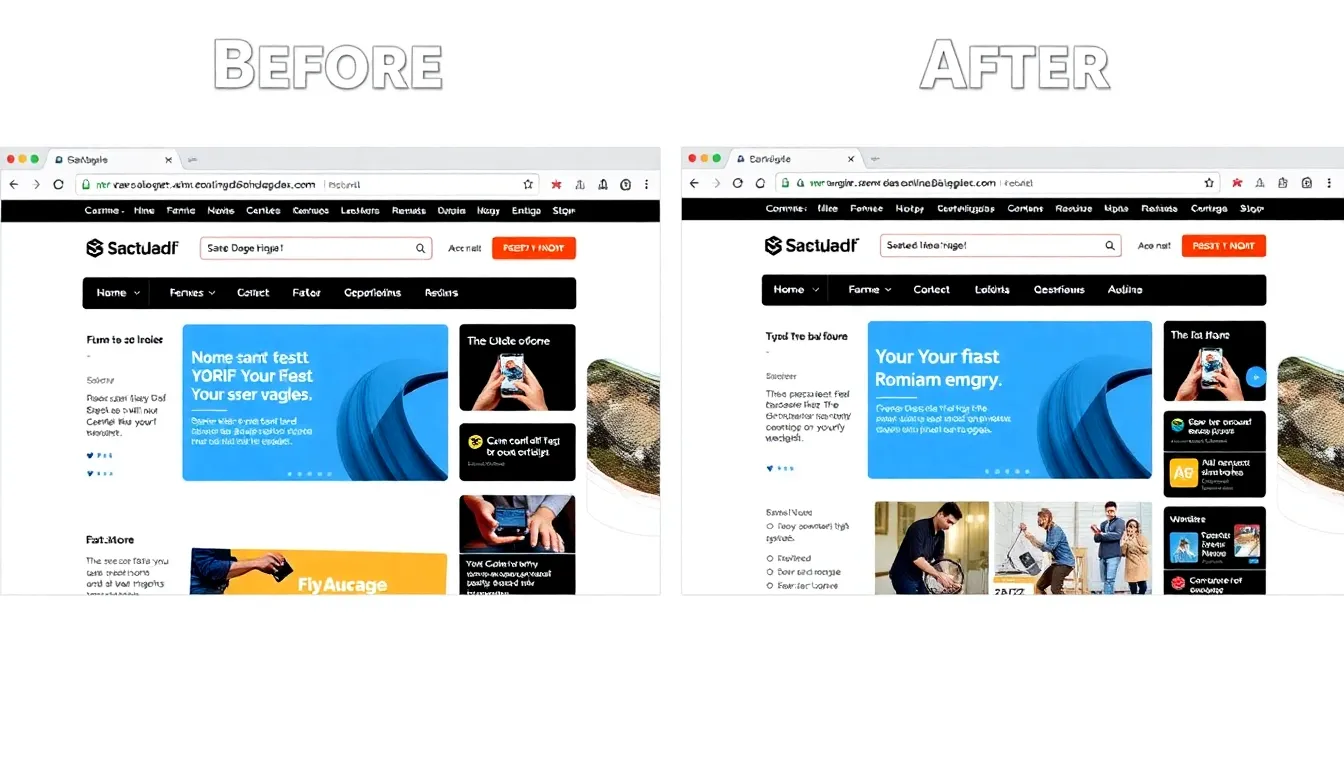The Ultimate Guide to Website Personalization: Boost Conversions by 300% in 2025

Website personalization has become the defining factor between businesses that merely survive and those that dominate their markets. Companies implementing comprehensive personalization strategies see average conversion rate improvements of 200-300%, with some achieving even higher gains. Yet despite these proven results, 78% of businesses still serve generic, one-size-fits-all experiences to their website visitors.
The difference isn’t just in conversion rates—it’s in customer lifetime value, user engagement, and competitive advantage. Personalization transforms your website from a passive brochure into an intelligent, adaptive sales engine that speaks directly to each visitor’s needs, preferences, and behavioral patterns.
This guide covers everything you need to know about website personalization: from fundamental concepts and psychological principles to advanced implementation strategies and measurement frameworks. Whether you’re just starting your personalization journey or looking to optimize existing efforts, you’ll find actionable insights to drive measurable results.
What You Will Learn
- Personalization Fundamentals: Core concepts, types, and psychological principles that drive results
- Strategic Framework: How to build a comprehensive personalization strategy from scratch
- Implementation Methods: Technical approaches from basic to advanced, including AI-powered solutions
- Content Strategy: Creating dynamic content that resonates with different audience segments
- Measurement & Analytics: Tracking ROI and optimizing personalization performance
- Advanced Techniques: Behavioral targeting, predictive personalization, and cross-channel integration
- Tools & Platforms: Comprehensive comparison of personalization technologies
- Real-World Examples: Case studies and proven tactics from successful implementations

Table of Contents
Open Table of Contents
- Personalization Fundamentals: Understanding the Core Principles
- The Psychology Behind Effective Personalization
- Building Your Personalization Strategy
- Types of Website Personalization
- Data Collection and Audience Segmentation
- Content Strategy for Personalized Experiences
- Technical Implementation Methods
- Advanced Personalization Techniques
- Measuring Personalization Success
- Tools & Technology Platforms
- Real-World Case Studies
- Best Practices Summary
- Conclusion & Next Steps
- FAQ Section
- How long does it take to see results from website personalization?
- What’s the difference between personalization and A/B testing?
- How much does website personalization typically cost?
- Do I need technical expertise to implement personalization?
- How do I ensure personalization complies with privacy regulations?
Personalization Fundamentals: Understanding the Core Principles
Website personalization is the practice of delivering individualized experiences to website visitors based on their characteristics, behavior, preferences, and context. Unlike traditional one-size-fits-all approaches, personalization creates unique experiences for different visitor segments or even individual users.
What Makes Personalization Effective
Relevance: Personalized content directly addresses visitor needs and interests, eliminating irrelevant information that creates friction in the conversion process.
Timing: Personalization delivers the right message at the optimal moment in the customer journey, whether someone is just discovering your brand or ready to make a purchase decision.
Context: Effective personalization considers not just who the visitor is, but also their current situation—device, location, referral source, and behavioral signals.
The Personalization Spectrum
Personalization exists on a spectrum from basic to sophisticated:
Basic Personalization:
- Geographic targeting (location-based content)
- Device-specific experiences (mobile vs. desktop)
- Referral source customization (ad campaign alignment)
Intermediate Personalization:
- Behavioral segmentation based on site interactions
- Dynamic content insertion based on visitor characteristics
- Email-triggered website experiences
Advanced Personalization:
- Real-time behavioral adaptation using machine learning
- Predictive content delivery based on likelihood models
- Cross-channel personalization orchestration
Key Performance Indicators
Successful personalization directly impacts these critical metrics:
- Conversion Rate: Average improvements of 20-300% depending on implementation depth
- Revenue Per Visitor: Typically increases 10-40% through better message-market fit
- Engagement Metrics: Time on site, pages per session, and return visitor rates all improve
- Customer Lifetime Value: Personalized experiences create stronger brand relationships
The Psychology Behind Effective Personalization
Understanding the psychological principles that make personalization effective is crucial for creating experiences that truly resonate with visitors.
Cognitive Biases That Drive Personalization Success
Confirmation Bias: People seek information that confirms their existing beliefs and preferences. Personalized content that aligns with visitor expectations feels more trustworthy and relevant.
Social Proof: Showing how similar visitors have behaved or what they’ve chosen creates powerful motivation for action. Personalized social proof is significantly more effective than generic testimonials.
Loss Aversion: People fear missing out on opportunities more than they value potential gains. Personalized urgency and scarcity messaging becomes more effective when tailored to specific visitor segments.
The Relevance-Trust Connection
Personalization works because relevant experiences build trust. When visitors see content that specifically addresses their situation, they perceive the brand as understanding and caring about their needs. This trust translates directly into higher conversion rates and customer loyalty.
Attention and Cognitive Load
Generic websites force visitors to mentally filter through irrelevant information to find what they need. Personalization reduces cognitive load by presenting only the most relevant options, making decision-making easier and faster.

Building Your Personalization Strategy
A successful personalization strategy requires systematic planning and execution. Here’s the framework that leading companies use to build personalization programs that deliver measurable results.
Phase 1: Foundation and Assessment
Current State Analysis
Begin by auditing your existing website performance:
- Conversion rates by traffic source, device, and page type
- Most common visitor paths and drop-off points
- Customer feedback and support inquiries patterns
- Existing data collection capabilities
Goal Setting and Success Metrics
Define specific, measurable objectives:
- Primary conversion rate improvement targets
- Secondary engagement metric goals
- Revenue impact expectations
- Timeline for achieving results
Resource Assessment
Evaluate your capabilities:
- Technical resources and development capacity
- Content creation and management resources
- Data analysis and optimization skills
- Budget allocation for tools and platforms
Phase 2: Audience Research and Segmentation
Customer Research
Deep dive into your audience characteristics:
- Demographic profiles and psychographic insights
- Behavioral patterns and preferences
- Pain points and decision-making triggers
- Content consumption preferences
Segmentation Strategy
Create meaningful visitor segments based on:
- Behavioral Data: Site interactions, purchase history, engagement patterns
- Demographic Information: Age, location, industry, company size
- Contextual Factors: Traffic source, device, time of visit
- Intent Signals: Search queries, page views, download behavior
Phase 3: Content and Experience Planning
Content Mapping
For each audience segment, map:
- Key messages that resonate most effectively
- Content formats and presentation styles
- Visual elements and design preferences
- Call-to-action language and placement
Experience Design
Plan personalized experiences that address:
- First-time vs. returning visitor needs
- Different stages of the buyer journey
- Various use cases and visitor goals
- Cross-device experience continuity
Phase 4: Implementation Roadmap
Prioritization Framework
Rank personalization opportunities by:
- Impact Potential: Expected conversion rate improvement
- Implementation Complexity: Technical difficulty and resource requirements
- Learning Value: Insights that will inform future optimization
- Risk Level: Potential negative impact if unsuccessful
Rollout Strategy
Plan your implementation:
- Start with high-impact, low-complexity opportunities
- Test on subset of traffic before full deployment
- Build measurement and monitoring capabilities
- Create feedback loops for continuous improvement
Types of Website Personalization
Understanding different personalization approaches helps you choose the right tactics for your specific goals and audience.
1. Geographic and Demographic Personalization
Location-Based Customization:
- Local contact information and office locations
- Region-specific product availability and pricing
- Cultural and language adaptations
- Weather-influenced content and offers
Demographic Targeting:
- Age-appropriate messaging and imagery
- Industry-specific use cases and examples
- Company size-relevant solutions and pricing
- Role-based content and navigation
2. Behavioral Personalization
Site Interaction History:
- Recently viewed products or content
- Category preferences based on browsing patterns
- Engagement level indicators (time spent, pages viewed)
- Previous conversion or goal completion behavior
Purchase and Engagement Patterns:
- Recommended products based on purchase history
- Content suggestions aligned with past interests
- Renewal and upgrade prompts for existing customers
- Win-back campaigns for lapsed users
3. Contextual Personalization
Traffic Source Optimization:
- Ad campaign-specific landing page content
- Social media platform-appropriate messaging
- Email campaign continuation and message match optimization
- Organic search query alignment
Device and Technology Context:
- Mobile-optimized experiences and functionality
- Browser-specific features and compatibility
- Connection speed-appropriate content loading
- Screen size and resolution adaptations
4. Temporal Personalization
Time-Based Variations:
- Business hours vs. after-hours messaging
- Seasonal content and promotional alignment
- Day-of-week behavioral pattern recognition
- Time zone-appropriate contact options
Journey Stage Personalization:
- Awareness stage educational content
- Consideration stage comparison tools
- Decision stage social proof and urgency
- Post-purchase onboarding and support

Data Collection and Audience Segmentation
Effective personalization relies on comprehensive data collection and intelligent segmentation strategies.
Data Sources and Collection Methods
First-Party Data Collection:
- Website analytics and behavior tracking
- Form submissions and registration data
- Customer relationship management (CRM) systems
- Email engagement and campaign responses
- Customer support interactions and feedback
Third-Party Data Integration:
- Social media profile information
- External demographic and firmographic databases
- Industry and market research data
- Partner and integration platform data
Real-Time Behavioral Signals:
- Current session behavior and navigation patterns
- Search query and referral source information
- Device and technical environment details
- Geographic location and time zone data
Advanced Segmentation Strategies
Behavioral Clustering
Use machine learning algorithms to identify natural behavior patterns:
- High-Intent Visitors: Multiple page views, pricing page visits, demo requests
- Research-Oriented Users: Long session duration, content downloads, comparison activities
- Quick Decision Makers: Direct navigation, single-session conversions
- Comparison Shoppers: Competitive analysis, feature comparison page visits
Predictive Segmentation
Leverage historical data to predict future behavior:
- Conversion Probability: Likelihood to convert based on current behavior
- Churn Risk: Probability of disengagement for existing customers
- Lifetime Value Prediction: Expected long-term customer value
- Product Interest Scoring: Affinity for specific products or services
Dynamic Segmentation
Create segments that automatically update based on new data:
- Progressive Profiling: Gradually collect more detailed information
- Behavioral Evolution: Segment changes based on interaction patterns
- Context-Sensitive Grouping: Segments that vary by situation or environment
- Multi-Dimensional Classification: Complex segments based on multiple criteria
Privacy and Compliance Considerations
Data Protection Best Practices:
- GDPR and CCPA compliance for data collection and usage
- Transparent privacy policies and consent management
- Data minimization principles and purpose limitation
- Security measures and breach protection protocols
Ethical Personalization:
- Avoiding discriminatory or harmful personalization
- Providing opt-out mechanisms and control options
- Balancing personalization benefits with privacy concerns
- Maintaining transparency about data usage and personalization logic
Content Strategy for Personalized Experiences
Creating effective personalized content requires strategic planning, systematic production, and continuous optimization.
Content Planning Framework
Message Architecture
Develop core messages for each audience segment:
- Value Propositions: Specific benefits that resonate with each segment
- Pain Point Addressing: Targeted solutions for segment-specific challenges
- Social Proof: Testimonials and case studies from similar customers
- Call-to-Action Variations: Action-oriented language that motivates each segment
Content Inventory and Mapping
Catalog existing content and identify gaps:
- Current Asset Audit: What content already exists for each segment
- Performance Analysis: Which content performs best for different audiences
- Gap Identification: Missing content needed for effective personalization
- Content Quality Assessment: Updates and improvements needed for existing materials
Dynamic Content Creation
Modular Content Design
Structure content for maximum flexibility:
- Component-Based Architecture: Headlines, descriptions, images that can be mixed and matched
- Variable Text Elements: Dynamic insertion points for personalized information
- Conditional Content Blocks: Sections that appear based on visitor characteristics
- Responsive Design Considerations: Content that works across all devices and contexts
Content Variation Development
Create systematic variations for different segments:
- Industry-Specific Examples: Use cases and benefits relevant to specific sectors
- Role-Based Messaging: Content tailored to different job functions and responsibilities
- Experience Level Adaptations: Beginner vs. advanced user content and navigation
- Geographic and Cultural Adaptations: Localized messaging and cultural considerations
Content Management and Optimization
Version Control and Organization
Manage multiple content variations effectively:
- Content Management System Setup: Organized structure for personalized content
- Version Tracking: Clear labeling and organization of content variations
- Approval Workflows: Quality control processes for personalized content
- Update and Maintenance Schedules: Regular review and optimization of content performance
Performance-Driven Content Optimization
Use data to continuously improve content effectiveness:
- A/B Testing Content Variations: Compare different personalized content approaches
- Engagement Metric Analysis: Track how different segments interact with content
- Conversion Rate Optimization: Focus on content that drives business results
- Feedback Integration: Incorporate customer feedback into content improvements

Technical Implementation Methods
Successfully implementing website personalization requires choosing the right technical approach based on your resources, goals, and technical constraints.
Implementation Approaches
Client-Side Personalization
JavaScript-based personalization executed in the visitor’s browser:
Advantages:
- Quick implementation without server changes
- Real-time adaptation based on user behavior
- Easy integration with existing websites
- Reduced server processing requirements
Considerations:
- Potential for content flashing before personalization loads
- Dependency on JavaScript functionality
- Limited access to server-side data
- SEO considerations for dynamic content
Server-Side Personalization
Personalization logic executed on the web server before content delivery:
Advantages:
- Seamless user experience without content flashing
- Full access to server-side data and business logic
- Better SEO optimization for personalized content
- Enhanced security and data protection
Considerations:
- More complex implementation requiring development resources
- Potential server performance impact with increased logic
- Longer implementation timeline
- Requires more sophisticated caching strategies
Hybrid Approaches
Combining server-side and client-side personalization for optimal results:
- Initial Server-Side Rendering: Core personalization delivered with the page
- Client-Side Enhancement: Additional personalization based on real-time behavior
- Progressive Enhancement: Gradually adding personalization layers as data becomes available
Technology Stack Considerations
Analytics and Data Collection
Essential tools for personalization data:
- Google Analytics 4: Enhanced measurement and audience building
- Adobe Analytics: Enterprise-level behavioral tracking and segmentation
- Mixpanel: Event-based analytics for detailed user behavior analysis
- Custom Data Platforms: Proprietary systems for specific business requirements
Content Management Integration
Connecting personalization with content systems:
- Headless CMS Solutions: Flexible content delivery for personalized experiences
- Traditional CMS Enhancement: Adding personalization capabilities to existing systems
- API-First Architecture: Decoupled content management for maximum flexibility
- Content Delivery Networks: Global content distribution for personalized experiences
Development Frameworks and Libraries
Technical tools for building personalization:
- React/Vue.js: Frontend frameworks for dynamic content rendering
- Node.js/Python: Backend technologies for personalization logic
- Machine Learning Libraries: TensorFlow, scikit-learn for advanced personalization
- API Integration Tools: Connecting multiple data sources and services
Performance and Scale Considerations
Caching Strategies
Balancing personalization with performance:
- Edge Caching: Geographic content distribution for personalized experiences
- Intelligent Cache Invalidation: Updating cached content when personalization rules change
- Partial Caching: Caching non-personalized content while dynamically generating personalized elements
- User-Specific Caching: Storing personalized content for repeat visitors
Load Testing and Optimization
Ensuring personalization doesn’t impact site performance:
- Performance Monitoring: Real-time tracking of page load times and user experience
- Stress Testing: Validating personalization performance under high traffic
- Database Optimization: Efficient data queries for personalization logic
- Content Delivery Optimization: Minimizing latency for personalized content
Advanced Personalization Techniques
Once you’ve mastered basic personalization, these advanced techniques can dramatically improve results and create competitive advantages.
Machine Learning-Powered Personalization
Predictive Content Delivery
Use algorithms to predict what content will be most effective:
- Content Recommendation Engines: Automatically suggest relevant content based on behavior patterns
- Conversion Probability Modeling: Predict which visitors are most likely to convert
- Optimal Timing Prediction: Deliver personalized content at the most effective moments
- Cross-Session Learning: Build visitor profiles across multiple site visits
Automated Segmentation
Let machine learning discover audience segments:
- Clustering Algorithms: Identify natural groupings in visitor behavior
- Collaborative Filtering: Find similarities between visitors for personalization
- Anomaly Detection: Identify unusual visitor patterns for special treatment
- Dynamic Segment Evolution: Automatically update segments as behavior patterns change
Cross-Channel Personalization
Omnichannel Experience Orchestration
Create consistent personalization across all touchpoints:
- Email-to-Website Continuity: Continue personalized messaging from email campaigns
- Social Media Integration: Align social content with website personalization
- Offline-to-Online Bridging: Connect in-store experiences with digital personalization
- Customer Service Integration: Personalize support interactions based on website behavior
Multi-Device Personalization
Maintain personalization across devices:
- Cross-Device Identity Resolution: Connect visitor behavior across multiple devices
- Context-Aware Adaptation: Adjust personalization based on current device capabilities
- Progressive Enhancement: Build personalization experiences that work on any device
- Seamless Experience Transfer: Continue personalized sessions across device switches
Real-Time Personalization
Behavioral Trigger Systems
Respond instantly to visitor actions:
- Exit-Intent Personalization: Dynamic content when visitors show leaving signals
- Engagement-Based Adaptation: Modify content based on current session engagement
- Real-Time Offer Optimization: Adjust offers based on immediate behavior signals
- Context-Sensitive Messaging: Change content based on real-time environmental factors
Dynamic A/B Testing
Automated optimization that learns and adapts:
- Multi-Armed Bandit Algorithms: Automatically allocate traffic to best-performing variations
- Contextual Bandits: Personalized A/B testing that considers visitor characteristics
- Adaptive Experimentation: Tests that automatically adjust based on performance
- Real-Time Statistical Analysis: Instant detection of significant results

Measuring Personalization Success
Comprehensive measurement and analytics are essential for optimizing personalization performance and proving ROI.
Key Performance Indicators (KPIs)
Primary Conversion Metrics
Focus on business-critical outcomes:
- Conversion Rate: Percentage improvement in primary goal completion
- Revenue Per Visitor: Average value generated per website visitor
- Customer Acquisition Cost: Cost efficiency improvements through better conversion
- Average Order Value: Impact on transaction size and profitability
Engagement and Experience Metrics
Track user experience improvements:
- Session Duration: Time spent on site and content engagement
- Pages Per Session: Depth of engagement and content consumption
- Bounce Rate: Percentage of single-page sessions
- Return Visitor Rate: Frequency of repeat visits and brand affinity
Advanced Attribution Metrics
Understand the full impact of personalization:
- Multi-Touch Attribution: Credit personalization across the customer journey
- Lifetime Value Impact: Long-term customer value improvements
- Cross-Channel Attribution: Personalization impact across multiple touchpoints
- Incremental Lift: True performance gain attributable to personalization
Analytics Setup and Tracking
Goal Configuration
Define and track meaningful objectives:
- Macro-Conversions: Primary business goals like purchases or leads
- Micro-Conversions: Supporting actions like newsletter signups or downloads
- Custom Events: Specific interactions relevant to your business model
- Value-Based Tracking: Assign monetary value to different conversion types
Segment Analysis
Compare performance across different groups:
- Personalized vs. Control Groups: Measure direct impact of personalization
- Segment Performance Comparison: Identify which segments benefit most
- Time-Based Analysis: Track performance improvements over time
- Statistical Significance Testing: Ensure results are reliable and actionable
Reporting and Optimization
Dashboard Creation
Build comprehensive performance monitoring:
- Executive Summary Dashboards: High-level performance overview for leadership
- Operational Dashboards: Detailed metrics for marketing teams
- Technical Performance Monitoring: System health and performance tracking
- Real-Time Alerting: Immediate notification of performance issues or opportunities
Continuous Improvement Process
Establish systematic optimization:
- Regular Performance Reviews: Scheduled analysis of personalization effectiveness
- Hypothesis-Driven Testing: Data-informed decisions about optimization opportunities
- Performance Benchmarking: Comparison against industry standards and competitors
- ROI Calculation and Reporting: Clear demonstration of personalization value
Tools & Technology Platforms
Choosing the right personalization platform is crucial for success. Here’s a comprehensive overview of available solutions and selection criteria.
Enterprise Personalization Platforms
Adobe Target
- Best For: Large enterprises with complex personalization needs
- Key Features: Advanced A/B testing, AI-powered recommendations, cross-channel orchestration
- Integration: Deep integration with Adobe Experience Cloud
- Pricing: Enterprise-level investment required
Optimizely
- Best For: Mid-to-large companies focused on experimentation
- Key Features: Robust A/B testing capabilities, feature flagging, statistical analysis
- Integration: Strong API and third-party integrations
- Pricing: Scalable pricing based on usage
Dynamic Yield
- Best For: E-commerce and retail companies
- Key Features: Real-time personalization, recommendation engines, behavioral targeting
- Integration: E-commerce platform specialization
- Pricing: Performance-based pricing models available
Mid-Market Solutions
VWO (Visual Website Optimizer)
- Best For: Companies wanting comprehensive conversion optimization
- Key Features: A/B testing, heatmaps, session recordings, personalization
- Integration: Easy implementation with minimal technical resources
- Pricing: Competitive pricing for mid-market businesses
Unbounce
- Best For: Marketing teams focused on landing page optimization
- Key Features: Drag-and-drop builder, A/B testing, dynamic text replacement
- Integration: Marketing automation and CRM integrations
- Pricing: Plan-based pricing suitable for growing businesses
AI-Powered Personalization Solutions
Adaptly
- Best For: Businesses seeking automated, no-setup personalization
- Key Features: AI-powered content adaptation, real-time optimization, privacy-first approach
- Integration: Simple JavaScript implementation
- Pricing: Performance-based pricing aligned with results
Tool Selection Criteria
Technical Requirements Assessment
Evaluate platforms based on your technical environment:
- Implementation Complexity: Developer resources required for setup and maintenance
- Performance Impact: Effect on website speed and user experience
- Scalability: Ability to handle traffic volume and data complexity
- Security and Compliance: Data protection and regulatory requirement support
Real-World Case Studies
Learn from successful personalization implementations across different industries and business models.
Case Study 1: SaaS Company - 240% Conversion Increase
Company: B2B project management software provider Challenge: Generic landing pages converting at 2.1% despite high-quality traffic Solution: Implemented role-based personalization targeting different job functions
Implementation Details:
- Created separate landing page experiences for project managers, executives, and team members
- Personalized value propositions, feature highlights, and social proof
- Used industry-specific examples and case studies
- Implemented progressive profiling to gather role information
Results:
- Overall conversion rate increased from 2.1% to 7.1% (240% improvement)
- Revenue per visitor improved by 180%
- Cost per acquisition decreased by 58%
- Customer lifetime value increased by 34% due to better initial fit
Key Learnings:
- Role-based personalization particularly effective in B2B environments
- Social proof from similar roles dramatically improves credibility
- Progressive profiling reduces form abandonment while enabling better personalization
Case Study 2: E-commerce Retailer - $2.3M Revenue Increase
Company: Online fashion retailer with diverse product catalog Challenge: High traffic but low engagement and conversion rates Solution: Behavioral personalization based on browsing patterns and preferences
Implementation Details:
- Analyzed customer browsing behavior to identify style preferences
- Created dynamic product recommendations based on viewed items
- Personalized homepage content based on previous purchases
- Implemented abandoned cart recovery with personalized product suggestions
Results:
- Conversion rate improved from 1.8% to 4.2% (133% increase)
- Average order value increased by 47%
- Annual revenue increase of $2.3 million
- Customer retention improved by 28%
Key Learnings:
- Behavioral data provides powerful personalization insights
- Product recommendations significantly impact both conversion and order value
- Cross-session personalization builds stronger customer relationships
Case Study 3: Financial Services - 156% Lead Generation Improvement
Company: Commercial bank targeting small business customers Challenge: Complex product offerings difficult to navigate for different business types Solution: Industry and company size-based personalization
Implementation Details:
- Segmented visitors by industry and company size
- Created industry-specific landing pages with relevant financial solutions
- Personalized rate and product information based on business characteristics
- Implemented dynamic forms collecting relevant business information
Results:
- Lead generation increased by 156%
- Qualified lead rate improved by 89%
- Sales conversion improved by 43%
- Customer satisfaction scores increased significantly
Key Learnings:
- Financial services benefit greatly from context-specific personalization
- Simplified navigation and relevant product focus reduces decision complexity
- Personalized forms improve both completion rates and lead quality
Best Practices Summary
Based on extensive research and real-world implementations, these best practices ensure personalization success:
Strategic Best Practices
- Start with Clear Objectives: Define specific goals and success metrics before implementation
- Focus on High-Impact Opportunities: Prioritize personalization efforts on pages and segments with greatest potential
- Build Gradually: Begin with simple personalization and evolve toward more sophisticated approaches
- Invest in Data Quality: Accurate, comprehensive data is the foundation of effective personalization
- Balance Personalization with Privacy: Respect user privacy while delivering relevant experiences
Implementation Best Practices
- Test Before Full Deployment: Always validate personalization effectiveness with controlled testing
- Monitor Performance Impact: Ensure personalization doesn’t negatively affect site speed or user experience
- Create Fallback Experiences: Plan for scenarios where personalization data isn’t available
- Implement Progressive Enhancement: Build experiences that work well even without personalization
- Document and Organize: Maintain clear documentation of personalization rules and content variations
Content and Experience Best Practices
- Maintain Brand Consistency: Ensure all personalized content aligns with brand voice and messaging
- Avoid Over-Personalization: Balance relevance with natural, non-intrusive experiences
- Focus on Value Addition: Personalization should genuinely improve the user experience
- Test Content Variations: Continuously optimize personalized content based on performance data
- Consider Context: Adapt personalization based on device, location, and situational factors
Measurement and Optimization Best Practices
- Track Multiple Metrics: Look beyond conversion rates to understand full personalization impact
- Use Statistical Significance: Ensure testing results are reliable before making decisions
- Monitor Long-Term Effects: Consider customer lifetime value and retention, not just immediate conversions
- Create Learning Loops: Use insights from personalization performance to inform future strategy
- Regular Performance Reviews: Schedule systematic analysis and optimization of personalization efforts
Conclusion & Next Steps
Website personalization represents one of the most powerful strategies for improving conversion rates, customer experience, and business performance in 2025. Companies that implement comprehensive personalization strategies consistently outperform those that rely on generic, one-size-fits-all approaches.
The journey from basic personalization to advanced, AI-powered experiences requires strategic planning, technical implementation, and continuous optimization. Success comes from understanding your audience deeply, implementing personalization systematically, and measuring results rigorously.
Your Personalization Journey Starts Here
The most important step is beginning with a clear strategy and realistic goals. Whether you’re implementing basic geographic targeting or advanced machine learning algorithms, focus on delivering genuine value to your visitors while building the data and insights needed for more sophisticated personalization.
Key Takeaways for Immediate Action
- Audit Your Current State: Analyze existing conversion rates and identify highest-impact personalization opportunities
- Define Your Strategy: Set clear goals, success metrics, and implementation timeline
- Start with High-Impact, Low-Complexity Changes: Geographic targeting, traffic source personalization, and basic behavioral adaptations
- Invest in Data Collection: Build the foundation for more advanced personalization through comprehensive analytics
- Choose the Right Tools: Select personalization platforms that align with your technical capabilities and business needs
The Future of Personalization
Personalization technology continues evolving rapidly. AI-powered solutions are making sophisticated personalization accessible to businesses of all sizes, while privacy-first approaches ensure sustainable, ethical implementation. Companies that build personalization capabilities now will have significant competitive advantages as these technologies become mainstream.
Ready to transform your website with AI-powered personalization? Adaptly’s intelligent personalization engine automatically optimizes your content for every visitor, delivering measurable results without complex setup or ongoing maintenance. Our privacy-first approach ensures compliance while maximizing conversion performance.
Related Resources:
- Learn about AI-Powered Website Personalization for automated optimization approaches
- Explore A/B Testing Landing Pages for systematic testing methodologies
- Discover Conversion Rate Optimization Fundamentals for comprehensive CRO strategies
- Master PPC Message Match for better ad-to-page alignment
Start Your Personalization Journey Today: Try Adaptly’s free 14-day trial and see how AI-powered personalization can transform your website performance.
FAQ Section
How long does it take to see results from website personalization?
Most businesses see initial results within 2-4 weeks of implementing personalization, with more significant improvements developing over 2-3 months as the system learns from visitor behavior. Simple personalization tactics like geographic targeting can show immediate results, while AI-powered personalization typically requires 30-60 days to gather sufficient data for optimization.
What’s the difference between personalization and A/B testing?
A/B testing compares different versions of content to find the best performer for all visitors, while personalization delivers different content to different visitor segments simultaneously. Personalization is like running multiple A/B tests at once, each optimized for specific audience characteristics. Many successful strategies combine both approaches for maximum effectiveness.
How much does website personalization typically cost?
Personalization costs vary significantly based on approach and scale. Basic geographic personalization can be implemented with existing tools at minimal cost, while enterprise personalization platforms range from $1,000-$50,000+ monthly. AI-powered solutions like Adaptly offer performance-based pricing that aligns costs with results, making sophisticated personalization accessible to businesses of all sizes.
Do I need technical expertise to implement personalization?
The technical requirements depend on your chosen approach. Modern no-code personalization platforms require minimal technical expertise—typically just adding a JavaScript snippet to your website. However, advanced personalization strategies may require development resources for custom implementation and integration with existing systems.
How do I ensure personalization complies with privacy regulations?
Privacy-compliant personalization focuses on first-party data collection with clear consent, transparent data usage policies, and providing user control over personalization preferences. Many modern personalization platforms, including Adaptly, are designed with privacy-first principles that ensure GDPR and CCPA compliance while delivering effective personalization.
